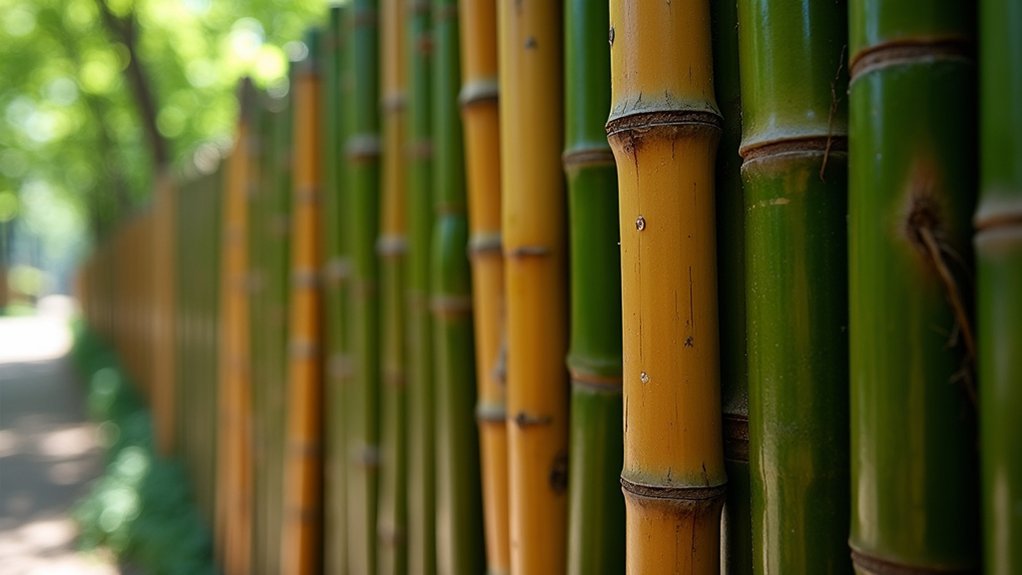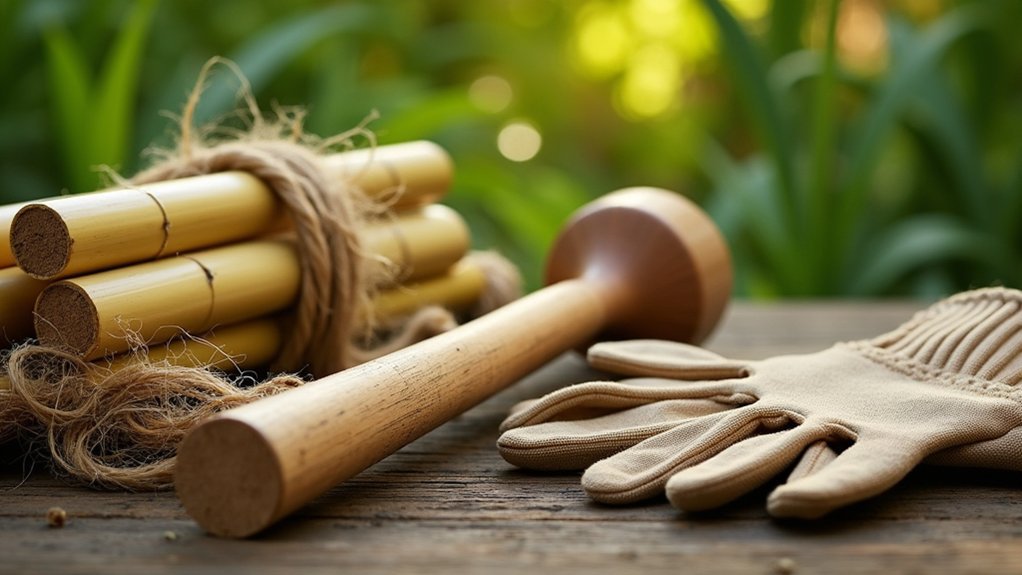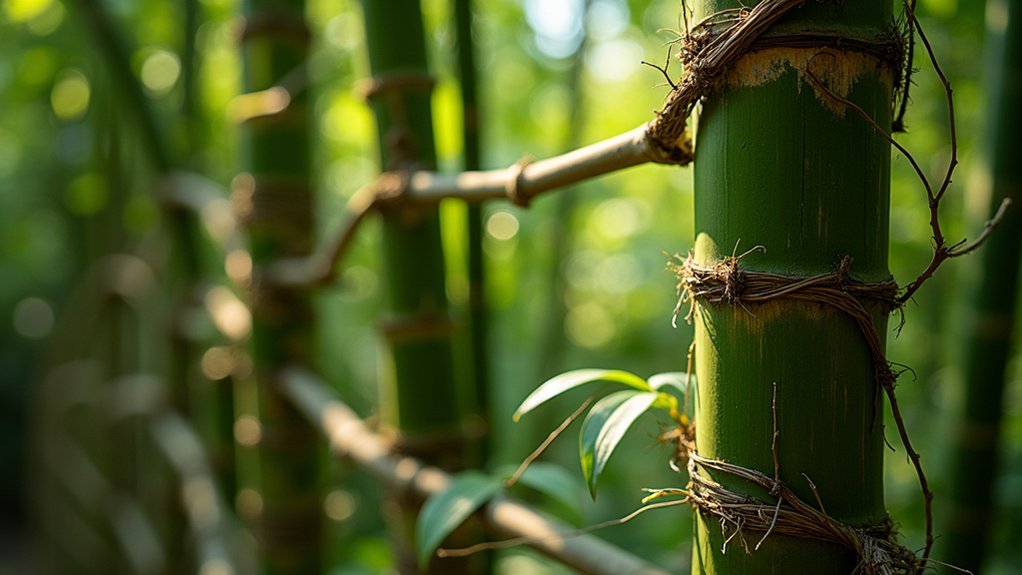Create elegant bamboo vine fences by selecting clumping varieties like Alphonse Karr for stability, positioning in south-facing locations for ideal sunlight, incorporating varying heights for visual interest, using stainless steel screws for durability, weaving smaller pieces through panels for texture, combining fast-growing vines with evergreens for year-round beauty, and installing rhizome barriers to prevent unwanted spread. These seven techniques will transform your outdoor space into a living, breathtaking sanctuary.
Selecting the Right Bamboo Varieties for Fence Stability

While creating a bamboo vine fence may seem straightforward, choosing the right bamboo variety greatly affects its long-term stability and success. Opt for clumping varieties like Alphonse Karr or Buddha’s Belly that form dense, compact growth without aggressive spreading, ensuring your bamboo fencing remains where you want it.
Consider mature height when selecting your bamboo. Varieties like Weaver’s bamboo exceed 30 feet tall, creating an excellent privacy screen while providing substantial structural support.
Choose species with high tensile strength—some rival steel in durability, making them ideal for long-lasting fences.
Match your bamboo to your local climate, as species thrive in specific temperature ranges and soil conditions.
Remember that regular maintenance including seasonal pruning and proper watering greatly enhances your fence’s stability and longevity.
Strategic Positioning for Sunlight and Growth Patterns
Your bamboo vine fence’s positioning will determine its growth success, with south-facing locations offering the ideal 6+ hours of direct sunlight needed for vibrant development.
You’ll want to adapt your planting strategy seasonally, considering how the sun’s path changes throughout the year to maintain consistent exposure for your climbing plants.
When installing trellises, angle them to encourage upward vine growth while regularly checking for competition from nearby structures or trees that might cast unwanted shade.
Ideal Sun Exposure Considerations
Because bamboo vines require abundant sunlight to develop their fullest potential, strategic positioning is essential for a thriving fence. Your bamboo fence will flourish with 6-8 hours of direct sunlight daily, producing denser foliage and stronger structural growth.
West-facing installations typically provide ideal conditions, as they receive maximum heat and light throughout the day.
- Avoid north-facing walls when possible, as limited sunlight exposure can stunt growth and create sparse coverage—consider adding reflective surfaces nearby if north-facing placement is unavoidable.
- Maintain proper spacing between plants to guarantee each section receives adequate sunlight and air circulation.
- Anticipate seasonal changes by positioning your bamboo fence where it won’t be excessively shaded by surrounding structures or deciduous trees during winter months.
Seasonal Growth Management
Successfully managing a bamboo vine fence throughout the year demands strategic planning for the changing seasons. Your bamboo fence will experience accelerated growth during spring and summer months, requiring designs that accommodate expansion while properly supporting climbing vines.
| Season | Bamboo Growth | Management Needs |
|---|---|---|
| Spring | Rapid | Install supports, monitor new shoots |
| Summer | Peak growth | Regular watering, train vines upward |
| Fall | Slowing | Prune back excessive growth, secure structure |
| Winter | Dormant | Protect from frost, assess trellis integrity |
| Early Spring | Revival | Soil amendment, prepare for new growth cycle |
Monitor seasonal changes closely, especially when integrating vines like lavender trumpet with your bamboo fence. Position structures on south or west-facing walls to maximize sunlight exposure throughout the year. Incorporate trellises to optimize vertical growth as seasons shift, and regularly assess soil conditions to maintain healthy plants during all growth phases.
Directional Planting Strategy
Strategic positioning determines the ultimate success of your bamboo vine fence, as sunlight exposure greatly impacts both growth rates and fence density.
When planning your layout, consider that west-facing locations receive more intense heat while north-facing areas provide less direct sunlight for your plants.
For ideal results:
- Assess your site’s sunlight patterns throughout different times of day, selecting fast-growing varieties that match your specific light conditions.
- Position taller bamboo species where they won’t cast shadows on shorter plants to prevent uneven growth.
- Utilize narrow spaces efficiently by choosing evergreen bamboo varieties that thrive in your garden’s particular exposure.
Remember to incorporate compatible companion plants that share similar light requirements to enhance both privacy and visual appeal of your bamboo vine fence.
Design Considerations for Aesthetic Appeal
While functionality remains important, the visual impact of your bamboo vine fence greatly influences your garden’s overall charm. Create dimension by incorporating varying bamboo cane heights and thicknesses in your fence design. This variation maintains visual interest while harmonizing with surrounding garden elements.
Choose fencing material that showcases natural bamboo colors or apply dark wood stains to complement traditional Japanese aesthetics. You’ll enhance elegance by weaving smaller diameter pieces through larger panels, adding texture and intricacy to your structure.
Consider integrating lattice or trellis components that support climbing vines, softening the fence’s appearance with lush greenery. Ascertain your design remains consistent with the landscape by selecting visually compatible bamboo varieties and scaling the fence appropriately to other garden features.
This thoughtful approach creates a cohesive, refined appearance.
Essential Tools and Materials for Construction

You’ll need quality cutting tools like a bamboo saw or fine hacksaw to precisely shape your fence components while protecting your hands with durable gloves.
Select robust, treated bamboo stalks that show consistent coloration and minimal cracks to guarantee your fence withstands the elements for years to come.
Secure your construction with weather-resistant materials such as stainless steel screws or wire, and finish with natural preservatives like hemp oil to enhance durability against moisture and insects.
Quality Cutting Implements
The right cutting tools make all the difference when constructing bamboo vine fences. For quality cutting implements, invest in a bamboo saw or fine hacksaw that delivers clean, precise cuts without damaging the natural structure of your bamboo poles. You’ll prevent unwanted splitting and create more professional-looking joints for your fence.
When assembling your fence components, remember to:
- Pre-drill holes before inserting screws or nails to prevent the bamboo from cracking
- Use sharp, dedicated bamboo cutting tools rather than general-purpose saws
- Maintain your cutting implements by cleaning and sharpening them regularly
Always wear sturdy gloves while handling and cutting bamboo to protect your hands from splinters that can easily embed in your skin during the construction process.
Robust Bamboo Selection
Selecting the right bamboo species forms the foundation of a durable and attractive vine fence that will stand the test of time. For ideal results, focus on robust bamboo species like black bamboo or golden bamboo, which offer exceptional durability and striking visual appeal.
These varieties can thrive for 8-10 years when properly maintained and provide privacy while enhancing your landscape’s aesthetic.
Remember that bamboo deteriorates quickly when contacting soil directly, typically lasting only 2-3 years without protection. To extend your fence’s lifespan, mount bamboo panels on treated hardwood posts rather than placing them directly in the ground.
This preventive measure creates a stable structure that resists decomposition. Additionally, regular application of natural preservatives like tung oil will greatly enhance your bamboo’s resistance to moisture and environmental damage.
Weather-Resistant Binding Materials
With your bamboo properly selected and mounted, securing these elements together becomes the next critical factor in fence durability.
Choose hemp twine or waxed lashing cord for weather resistance as bamboo grows and settles into its final position. Rather than nailing directly into the poles, drill pilot holes first to prevent damaging splits and preserve structural integrity.
For peak longevity of your binding materials:
- Combine stainless steel screws or fine wire with traditional bindings for enhanced structural strength
- Apply natural preservatives like hemp oil or tung oil to protect bindings from moisture damage
- Schedule regular inspections every six months to check for deterioration or loosening that could compromise your fence’s stability
Maintaining your binding materials properly guarantees your bamboo vine fence remains both beautiful and sturdy through changing seasons.
Step-by-Step Assembly Techniques for Durability

Four critical stages define the assembly process of a durable bamboo vine fence.
Begin with thorough planning, marking support pole positions and guaranteeing level ground. This preparation is essential for the fence’s structural integrity.
Next, dig holes for treated wood support poles, embedding them securely to create a solid foundation for your bamboo panels.
When attaching these panels, use stainless steel screws or wire for modern installations, or weave smaller bamboo pieces for a traditional aesthetic.
Finally, protect your investment with regular maintenance.
Apply UV-resistant sealant to shield against moisture and sunlight damage. Ascertain proper drainage around the fence to prevent water accumulation that leads to rot.
These preventative measures greatly extend your fence’s lifespan while preserving its natural beauty.
Companion Vine Selection for Seasonal Display
The right vines transform your well-built bamboo fence into a living masterpiece of color and texture throughout the year.
For ideal results with your bamboo fencing, combine fast-growing options like the lavender trumpet vine with evergreen climbers such as star jasmine to guarantee year-round appeal.
- Seasonal Showstoppers – Plant morning glory for summer bursts of color, reaching 10-15 feet in a single season, creating dramatic vertical impact against bamboo.
- Wildlife Attractors – Include honeysuckle and climbing roses to invite pollinators, hummingbirds, and butterflies while adding fragrance to your outdoor space.
- Year-Round Privacy – Incorporate evergreen varieties alongside seasonal bloomers to maintain privacy and structure during winter months when deciduous vines go dormant.
Maintaining Structure and Preventing Overgrowth

Managing a bamboo vine fence requires vigilant attention to prevent the spectacular growth from becoming an unwieldy problem for you and your neighbors. Regular monitoring is essential, as bamboo can grow up to 4 feet daily.
Install underground barriers or use galvanized containers to contain running bamboo varieties and their aggressive rhizomes. Annual pruning maintains structure while preventing overcrowding and improving light penetration.
| Maintenance Task | Frequency | Benefit |
|---|---|---|
| Growth monitoring | Weekly | Prevents boundary encroachment |
| Rhizome barrier check | Quarterly | Contains spread |
| Structural pruning | Annually | Maintains fence integrity |
| Preservative application | Bi-annually | Extends lifespan by 2-3 years |
Ensure proper drainage around your bamboo to prevent root rot. Applying natural preservatives protects against degradation, which typically begins within 2-3 years when bamboo contacts soil, maintaining structure and preventing overgrowth simultaneously.
Frequently Asked Questions
What Is the Disadvantage of a Bamboo Fence?
Bamboo fences rot when contacting ground, lasting only 10-20 years—shorter than alternatives. You’ll face challenges attaching flat wood to round bamboo, and you’ll notice cracking and graying without regular maintenance. Improper installation causes instability issues.
How to Care for a Bamboo Fence?
To care for your bamboo fence, check for rot regularly, apply hemp or tung oil annually, guarantee proper drainage, reapply UV-resistant sealant every few years, and replace any cracked sections promptly to maintain stability.
How to Rejuvenate a Bamboo Fence?
To rejuvenate your bamboo fence, inspect for rot, clean with mild detergent, apply hemp or tung oil as a preservative, reinforce loose joints with stainless steel screws, and re-stain annually with UV-resistant sealer.
What Is the Downside of Bamboo Plants?
Bamboo’s downsides include invasive spreading through rhizomes, potential structural damage to buildings, quick rotting when in soil, cyanide content in raw shoots, and costly removal or containment measures you’ll need to implement.
In Summary
You’ve now got all the essentials for creating a bamboo vine fence that’s both functional and beautiful. Remember, your choice of materials, thoughtful design, and regular maintenance will determine how well your fence thrives. Don’t hesitate to experiment with seasonal vines for year-round interest. With these seven tips, you’ll enjoy your elegant living boundary for years to come.





Leave a Reply